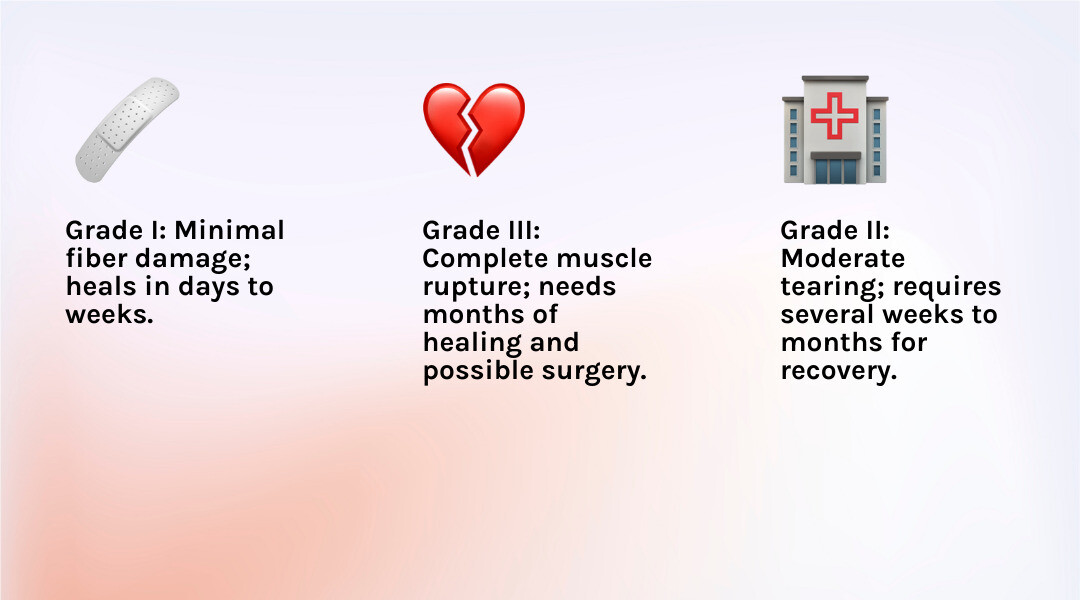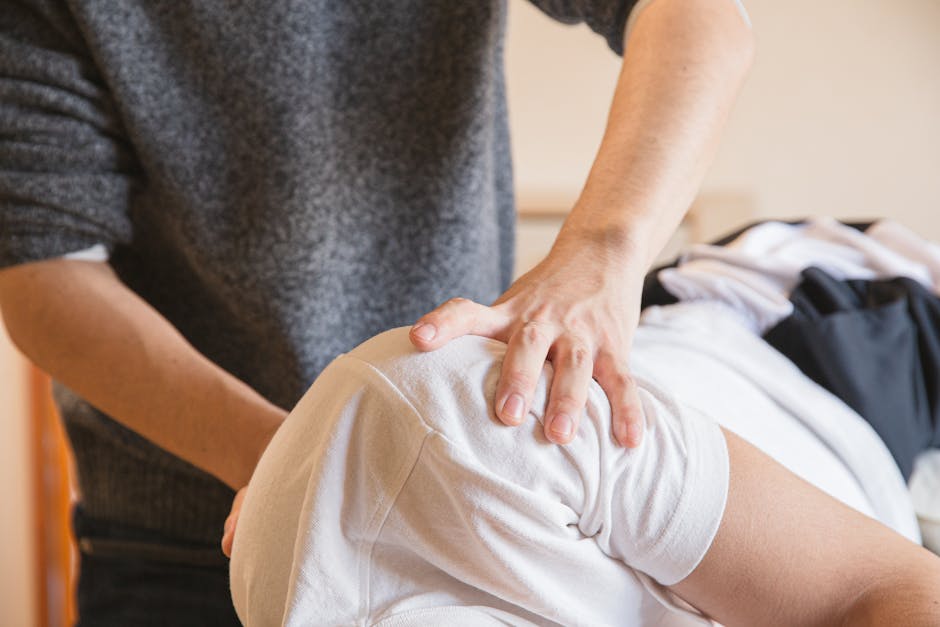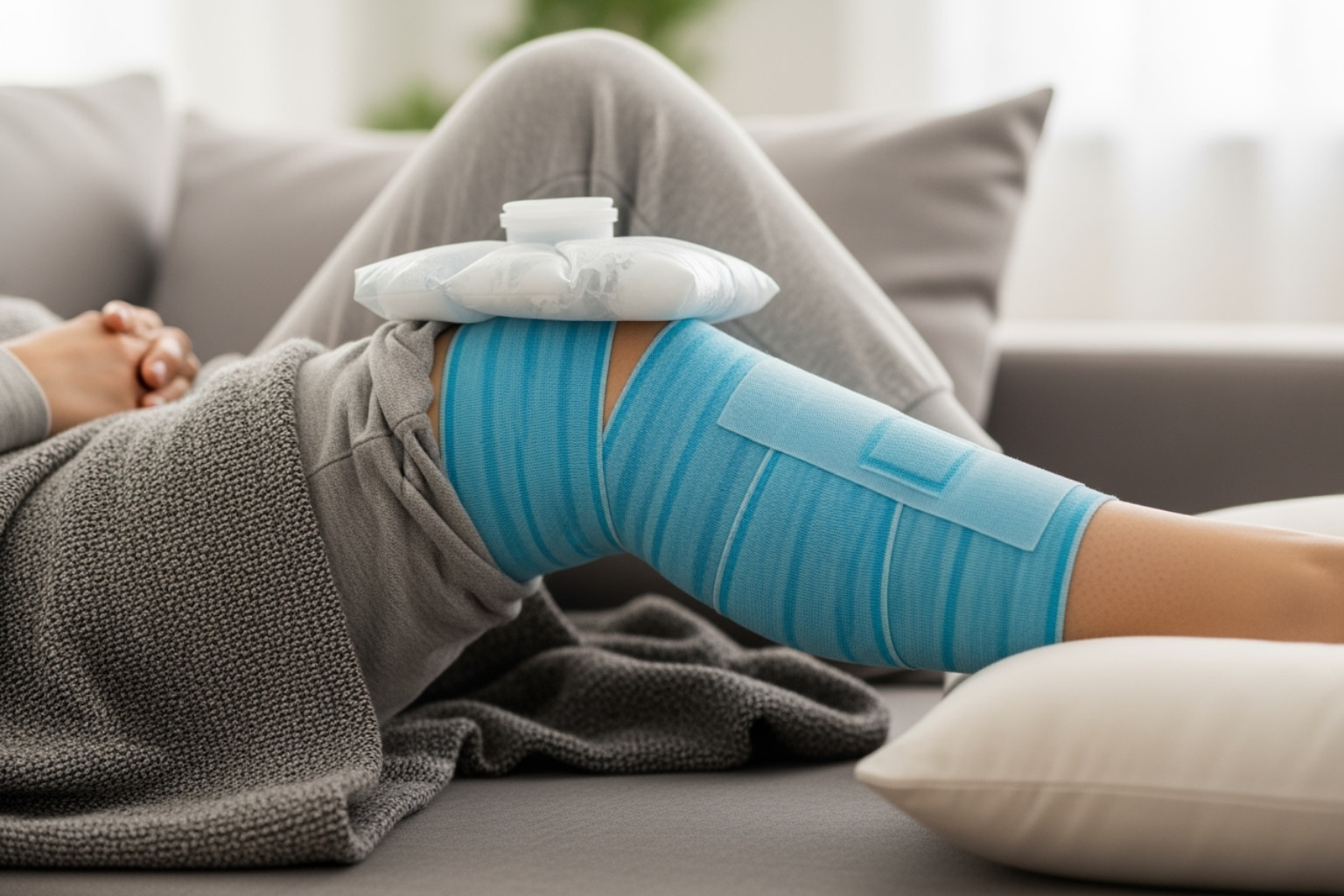Why Fast Muscle Strain Recovery Matters
How to speed up muscle strain recovery requires a multi-step approach. Getting back to full strength quickly is crucial, whether you're an athlete or dealing with an everyday strain.
Quick Answer: Essential Steps to Speed Recovery
- Assess severity – Know when to see a doctor vs. self-treat
- Apply RICE immediately – Rest, Ice (15-20 min), Compression, Elevation for first 72 hours
- Manage pain properly – Use ice first, then heat after 72 hours; consider topical relief
- Fuel recovery – Consume 1.4-2.0g protein/kg body weight daily
- Prioritize sleep – Get 7-9 hours for tissue repair
- Start gentle movement – Light stretching and isometric exercises after acute phase
- Prevent re-injury – Warm up properly, strengthen muscles, listen to your body
A muscle strain, or pulled muscle, happens when muscle fibers overstretch or tear, causing a sudden, sharp pain that can keep you from your favorite activities.
The good news is you can actively speed up your recovery. This guide provides proven steps for the critical first hours, nutritional support, and when to see a professional.

Step 1: Assess the Damage & Know When to Get Help
To speed up muscle strain recovery, you first need to assess the injury. A muscle strain is a tear in the muscle fibers or tendons. The severity, from a microscopic tear to a significant one, dictates your recovery strategy.

Key Symptoms of a Muscle Strain
Listen to your body. Key symptoms of a muscle strain include:
- Sudden pain at the moment of injury, ranging from a dull ache to a sharp sensation.
- Tenderness, swelling, and bruising may appear as your body's natural healing response begins.
- Muscle weakness and a limited range of motion, making movement difficult or painful.
- Muscle spasms or a popping sound at the time of injury can indicate a serious tear requiring medical attention.
Is It a Strain or Just Post-Workout Soreness?
It's easy to confuse a strain with delayed onset muscle soreness (DOMS). The key difference is timing. A strain hurts immediately, while DOMS appears 24-72 hours later.
Strain pain is sharp and localized, worsening with movement. DOMS, as described by the American College of Sports Medicine (ACSM), is a dull, generalized ache that often improves with light activity. A good rule of thumb: If pain worsens by day three, it's likely a strain. If it's improving, it's probably DOMS.
| Feature | Muscle Strain | Delayed Onset Muscle Soreness (DOMS) |
|---|---|---|
| Pain Onset | Immediate, at the moment of injury. | 24-72 hours after exercise. |
| Pain Location | Localized to a specific spot in the muscle. | Generalized soreness across a muscle group that was worked. |
| Pain Character | Sharp, sudden, often intense; worsens with movement of the affected muscle. | Dull, aching, stiff; typically improves with light movement. |
| Duration | Can last days to weeks, or even months for severe strains. | Usually resolves within 3-5 days. |
When to See a Doctor for a Pulled Muscle
While most mild strains can be treated at home, some symptoms require a doctor. Ignoring them can lead to long-term problems. As Lauren Powell, M.D., a family medicine physician at Piedmont, puts it: "If you think you have pulled a muscle, I always recommend being evaluated by a medical professional to ensure a proper diagnosis."
See a doctor immediately for: severe pain, inability to bear weight, an obvious deformity in the muscle, or if you heard a popping sound. Also seek medical care for fever or chills, broken skin at the site, or numbness and tingling, which could indicate infection or nerve damage.
If pain persists or worsens after 24 hours of home care, see a professional. Proper guidance on how to speed up muscle strain recovery is crucial for avoiding chronic issues. When in doubt, get it checked out.
Step 2: Master Immediate Care (The First 72 Hours)
The first 48 to 72 hours are critical to speed up muscle strain recovery. During this initial inflammatory phase, the goal is to manage pain, reduce swelling, and prevent further injury.

Applying the RICE Method for Initial Relief
The RICE method (Rest, Ice, Compression, Elevation) is a proven first-aid treatment for muscle strains, recommended by the American Academy of Orthopaedic Surgeons (AAOS).
- Rest: Stop the activity that caused the pain. Pushing through can worsen the injury and prolong recovery.
- Ice: To reduce pain and swelling, apply an ice pack wrapped in a towel for 15-20 minutes every few hours during the first 48-72 hours.
- Compression: Wrap the area firmly, but not too tightly, with an elastic bandage. It should be supportive without causing numbness or more pain.
- Elevation: Whenever possible, raise the injured limb above the level of your heart to help reduce swelling.
The American Academy of Orthopaedic Surgeons (AAOS) has more detailed guidance you can check out here.
A Modern Approach: Gentle Protection and Active Recovery
A more modern approach is the PEACE and LOVE method. It recognizes that some inflammation is necessary for healing and encourages gentle movement sooner.
The PEACE protocol is for the first few days:
- Protection: Reduce activity and avoid pain for the first 1-3 days to protect from further injury.
- Elevation: Lift the limb above the heart to reduce swelling.
- Avoid Anti-inflammatories: Some inflammation is part of healing. Avoid overusing anti-inflammatory medications and ice unless directed by a doctor.
- Compression: Use an elastic bandage to limit swelling and support the muscle.
- Education: Understand your condition and the principles of active recovery.
After the initial PEACE phase, the focus shifts to LOVE:
- Load: Gently reintroduce pain-free activity. Your body needs some mechanical stress to stimulate repair.
- Optimism: A positive mindset can aid recovery. Be confident in your body's ability to heal.
- Vascularization: Engage in pain-free cardio to increase blood flow to the injured tissue.
- Exercise: Begin targeted exercises to restore strength and mobility once cleared by a professional.
This balanced strategy is key to how to speed up muscle strain recovery and build back stronger.
Step 3: How to Speed Up Muscle Strain Recovery with Advanced Techniques
After the first 72 hours, the focus shifts from managing acute symptoms to actively promoting healing. This proactive phase is crucial for how to speed up muscle strain recovery.

Transitioning from Ice to Heat and Managing Pain
After initial swelling subsides, you can switch from ice to heat. As recommended by the Mayo Clinic, heat increases blood flow, delivering nutrients for repair and soothing tight muscles. Apply a heating pad for 15-20 minutes at a time. Warm baths or contrast therapy (alternating hot and cold) can also help.
Over-the-counter pain relievers can manage discomfort, but be mindful of NSAID use in the early stages, as some inflammation is necessary for healing. Always consult your doctor.
For targeted relief, topical creams like Neuropasil Muscle Pain Relief Cream are effective. They deliver soothing ingredients like menthol directly to the painful area, providing comfort without oral medication and making gentle movement easier. Learn more about Topical vs. Oral Pain Relief Options.
How to Speed Up Muscle Strain Recovery with Proper Nutrition and Hydration
Your diet is essential to speed up muscle strain recovery. Your body needs the right nutrients to rebuild damaged tissue.
- Protein is vital for muscle repair. Aim for 1.4–2.0 grams of protein per kilogram of body weight daily from sources like lean meats, fish, and eggs. A systematic review confirms the benefits of protein.
- Carbohydrates from whole grains, fruits, and vegetables provide the energy needed for healing.
- Anti-inflammatory foods like tart cherry juice, omega-3s from fatty fish, and antioxidant-rich fruits and vegetables can also help.
- Hydration is non-negotiable. Water transports nutrients and removes waste. Follow USADA hydration guidelines and drink fluids consistently.
How to Speed Up Muscle Strain Recovery through Smart Lifestyle Choices
Daily habits significantly impact how to speed up muscle strain recovery.
- Sleep is a powerful recovery tool. During deep sleep, your body releases growth hormone essential for tissue repair. Research shows sleep deprivation impairs muscle recovery. Aim for 7-9 hours of quality sleep nightly.
- Avoid alcohol, as research shows it can impair muscle protein synthesis and disrupt recovery.
- Smoking also impairs healing by reducing blood flow and oxygen to your tissues, with studies confirming its adverse effects on soft-tissue healing.
These lifestyle choices create an optimal environment for healing. For more tips, see our guide on what helps sore muscles.
Step 4: Rebuild Strength and Prevent Future Injury
After the initial pain and swelling subside, the rehabilitation phase begins. This is a key part of how to speed up muscle strain recovery, focusing on rebuilding strength and preventing re-injury.

The Role of Gentle Movement and Physical Therapy
Too much rest can slow recovery, leading to stiffness and weakness. Gentle movement is necessary to guide proper healing.
- Active recovery should begin as soon as you can move without significant pain. Simple, gentle movements increase blood flow and promote healing. Do not push through pain.
- Gentle stretching helps restore flexibility. Hold static stretches for 20-30 seconds without pain, a duration supported by the American College of Sports Medicine (ACSM) to improve flexibility.
- Isometric exercises, which involve contracting the muscle without moving the joint, are excellent for building strength without stressing healing tissue.
For moderate to severe strains, a physical therapist can be invaluable. They create a personalized plan with targeted exercises and may use manual therapy techniques like massage or myofascial release to speed up healing. A physical therapist can also teach you proper body mechanics to prevent future injuries. Learn more in our guide to muscle strain treatment.
Strategies to Prevent Future Muscle Strains
After recovery, focus on prevention to avoid re-injury. This requires consistency and body awareness.
- Proper warm-up: Always perform a warm-up before activity. Start with light cardio, followed by dynamic stretching (like leg swings and arm circles).
- Cool-down: A cool-down with static stretches helps maintain flexibility.
- Correct lifting technique: Bend at your knees, not your waist, and use your leg muscles. Keep the object close to your body and avoid twisting.
- Good posture: Proper alignment distributes stress evenly across muscles and joints. The Cleveland Clinic explains the importance of good posture.
- Strengthening and conditioning: A balanced fitness program builds resilient muscles. Focus on core strength and correcting muscle imbalances.
- Listen to your body: Don't push through pain or fatigue. Respecting your body's signals and avoiding overtraining is key to long-term health.
These prevention strategies are an investment in a resilient, pain-free future.
Frequently Asked Questions about Muscle Strain Recovery
Here are answers to common questions about how to speed up muscle strain recovery.
How long does a pulled muscle take to heal?
Healing time depends on the severity of the strain, which is classified by grades. According to the Cleveland Clinic, recovery timelines can vary significantly:
- Grade 1 (mild): A few stretched fibers. Often heals within a few weeks.
- Grade 2 (moderate): A partial tear of muscle fibers. Recovery can take up to three months or longer.
- Grade 3 (severe): A complete muscle rupture, often accompanied by a "pop." This serious injury may require surgery and takes months of rehabilitation to heal.
Don't rush your recovery. Returning to activity too soon risks re-injury.
Can massage help a muscle strain?
Yes, but timing is crucial. Avoid deep massage on the strain during the first 48-72 hours, as it can worsen swelling. After the initial inflammatory phase, massage is a valuable tool. A 2020 review found it improves flexibility and reduces soreness. For a strain, it can improve circulation, reduce tension, and break down scar tissue. Work with a professional trained in injury recovery who can apply the right techniques, like myofascial release, for your stage of healing.
What can help with muscle recovery?
To speed up muscle strain recovery, a holistic approach is best.
- Rest and manage inflammation initially with ice, then use heat to boost circulation. Compression and elevation are also key.
- Manage pain to allow for gentle movement. Topical options like Neuropasil Muscle Pain Relief Cream provide targeted, soothing comfort with menthol and natural ingredients, directly on the affected area.
- Proper nutrition is your internal medicine. Consume adequate protein (1.4-2.0 g/kg of body weight), stay hydrated, and eat anti-inflammatory foods to support healing from within.
- Prioritize sleep (7-9 hours) for tissue regeneration. Avoid alcohol and smoking, which hinder the healing process.
- Incorporate gentle movement and stretching to prevent stiffness. A physical therapist can provide guidance for safely rebuilding strength.
For more details, read our guide on muscle recovery strategies. Every piece of the puzzle matters for a quick and complete recovery.
Conclusion: Your Path to a Faster, Stronger Recovery
A muscle strain is frustrating, but how to speed up muscle strain recovery is not a mystery. Your body can heal effectively with the right support.
This guide provided a complete roadmap: assessing the damage, applying immediate care (RICE/PEACE & LOVE), and using advanced techniques like heat therapy, proper nutrition, and prioritizing sleep. We also covered rebuilding strength and preventing future injuries. This comprehensive approach supports your body's natural healing process for a faster recovery.
Patience and action are key. Don't rush, but be proactive. Listen to your body, rest when needed, move when ready, and provide the right fuel for rebuilding.
For targeted relief, Neuropasil Muscle Pain Relief Cream offers natural, fast-acting comfort. Its formula with Aloe, Urea, and Menthol soothes muscle pain, supporting your recovery. It's a trusted companion for athletes and anyone dealing with muscle aches and strains.
Now you know how to speed up muscle strain recovery. Put this knowledge into action, be patient, and trust the process. You'll be back to your activities, stronger than before. Find the best topical solutions for pulled muscles to start your journey to a faster recovery.
References
We believe in providing you with information you can trust and empowering you with knowledge. That's why the insights and recommendations shared throughout this guide are grounded in reputable research and expert advice. Below, you'll find the sources that informed our content, so you can dig deeper and feel confident in your journey to speed up muscle strain recovery.
- American Academy of Orthopaedic Surgeons. (n.d.). Muscle Strains in the Thigh. OrthoInfo. Retrieved from http://orthoinfo.aaos.org/topic.cfm?topic=a00366
- Barnes, M. J. (2014). Alcohol: impact on sports performance and recovery. Sports Medicine, 44(7), 909–919. https://link.springer.com/article/10.1007/s40279-014-0192-8
- Cleveland Clinic. (2020). The Health Effects of Poor Posture. Retrieved from https://health.clevelandclinic.org/health-effects-of-poor-posture
- Cleveland Clinic. (2023). Sprains, Strains and Tears. Retrieved from https://my.clevelandclinic.org/health/diseases/22227-sprains-strains-and-tears
- Dattilo, M., et al. (2020). Effects of Sleep Deprivation on Acute Skeletal Muscle Recovery After Exercise. Medicine & Science in Sports & Exercise, 52(2), 507-514. https://journals.lww.com/acsm-msse/Abstract/2020/02000/EffectsofSleepDeprivationonAcuteSkeletal.28.aspx
- Davis, H. L., et al. (2020). The effect of sports massage on performance and recovery: a systematic review and meta-analysis. BMJ Open Sport & Exercise Medicine, 6(1), e000614. https://www.ncbi.nlm.nih.gov/pmc/articles/PMC7228568/
- Dubois, B., & Esculier, J. F. (2020). Soft-tissue injuries simply need PEACE and LOVE. British Journal of Sports Medicine, 54(2), 72–73. https://bjsm.bmj.com/content/bjsports/54/2/72.full.pdf
- Garber, C. E., et al. (2011). American College of Sports Medicine position stand. Quantity and quality of exercise for developing and maintaining cardiorespiratory, musculoskeletal, and neuromotor fitness in apparently healthy adults: guidance for prescribing exercise. Medicine & Science in Sports & Exercise, 43(7), 1334-1359. https://www.ncbi.nlm.nih.gov/pubmed/21694556
- Mayo Clinic Staff. (n.d.). Sprain: Diagnosis & treatment. Mayo Clinic. Retrieved from https://www.mayoclinic.org/diseases-conditions/sprains/diagnosis-treatment/drc-20377943
- Morton, R. W., et al. (2018). A systematic review, meta-analysis and meta-regression of the effect of protein supplementation on resistance training-induced gains in muscle mass and strength in healthy adults. British Journal of Sports Medicine, 52(6), 376–384. https://www.ncbi.nlm.nih.gov/pmc/articles/PMC5867436/
- Powell, L. W. (n.d.). Lauren W. Powell, M.D. Piedmont. Retrieved from https://doctors.piedmont.org/provider/Lauren+W+Powell/390340
- Torgan, C. (n.d.). Delayed Onset Muscle Soreness (DOMS). American College of Sports Medicine. Retrieved from https://www.acsm.org/docs/default-source/files-for-resource-library/delayed-onset-muscle-soreness-(doms).pdf
- U.S. Anti-Doping Agency. (n.d.). Fluids and Hydration. Retrieved from https://www.usada.org/athletes/substances/nutrition/fluids-and-hydration/
- Ziran, B. H., et al. (2013). The effects of smoking and nicotine on fracture healing. Current Reviews in Musculoskeletal Medicine, 6(4), 314–321. https://www.ncbi.nlm.nih.gov/pmc/articles/PMC4094088/














